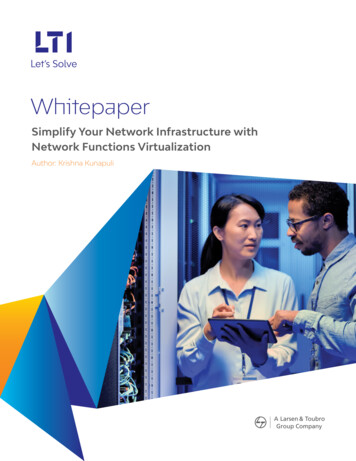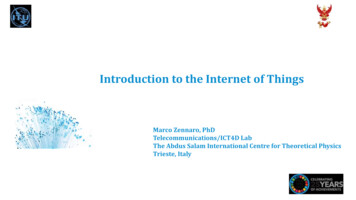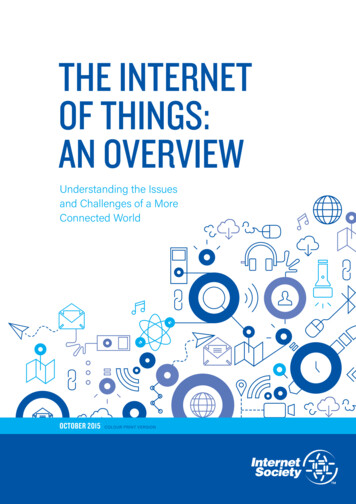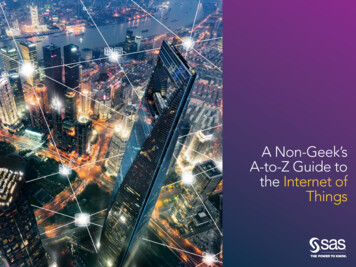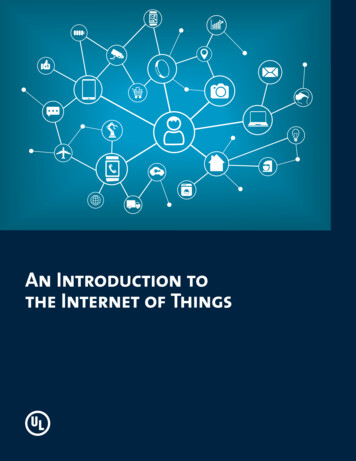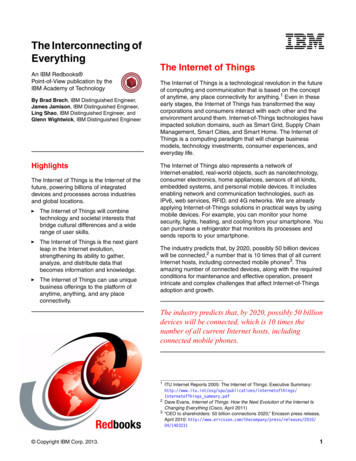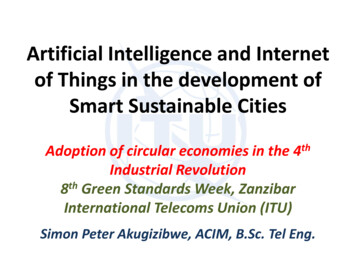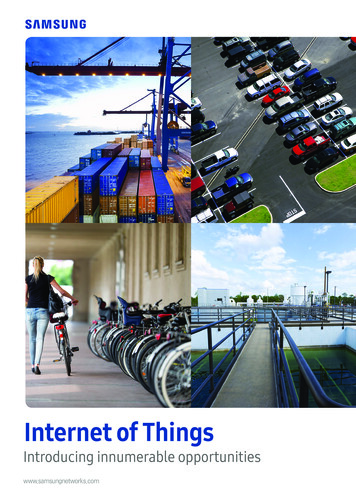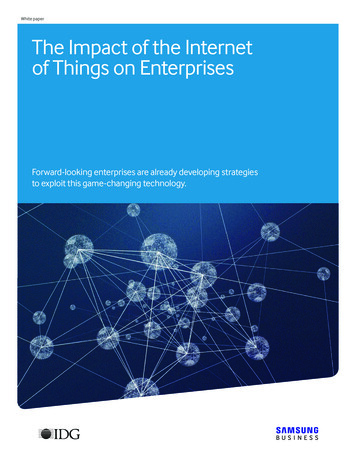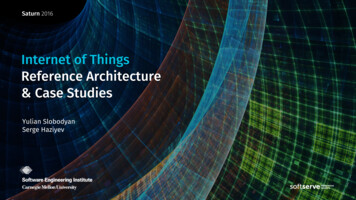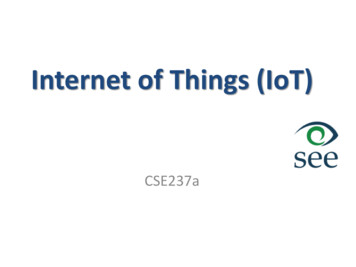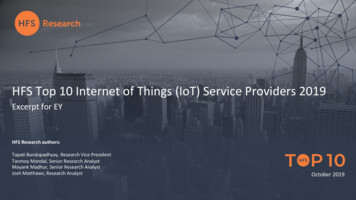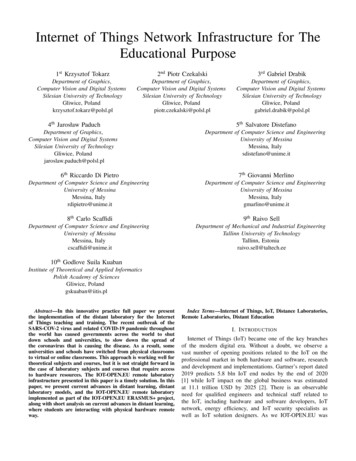
Transcription
Internet of Things Network Infrastructure for TheEducational Purpose1st Krzysztof Tokarz2nd Piotr Czekalski3rd Gabriel DrabikDepartment of Graphics,Computer Vision and Digital SystemsSilesian University of TechnologyGliwice, Polandkrzysztof.tokarz@polsl.plDepartment of Graphics,Computer Vision and Digital SystemsSilesian University of TechnologyGliwice, Polandpiotr.czekalski@polsl.plDepartment of Graphics,Computer Vision and Digital SystemsSilesian University of TechnologyGliwice, Polandgabriel.drabik@polsl.pl4th Jarosław Paduch5th Salvatore DistefanoDepartment of Graphics,Computer Vision and Digital SystemsSilesian University of TechnologyGliwice, Polandjaroslaw.paduch@polsl.plDepartment of Computer Science and EngineeringUniversity of MessinaMessina, Italysdistefano@unime.it6th Riccardo Di Pietro7th Giovanni MerlinoDepartment of Computer Science and EngineeringUniversity of MessinaMessina, Italyrdipietro@unime.itDepartment of Computer Science and EngineeringUniversity of MessinaMessina, Italygmarlino@unime.it8th Carlo Scaffidi9th Raivo SellDepartment of Computer Science and EngineeringUniversity of MessinaMessina, Italycscaffidi@unime.itDepartment of Mechanical and Industrial EngineeringTallinn University of TechnologyTallinn, Estoniaraivo.sell@taltech.ee10th Godlove Suila KuabanInstitute of Theoretical and Applied InformaticsPolish Academy of SciencesGliwice, Polandgskuaban@iitis.plAbstract—In this innovative practice full paper we presentthe implementation of the distant laboratory for the Internetof Things teaching and training. The recent outbreak of theSARS-COV-2 virus and related COVID-19 pandemic throughoutthe world has caused governments across the world to shutdown schools and universities, to slow down the spread ofthe coronavirus that is causing the disease. As a result, someuniversities and schools have switched from physical classroomsto virtual or online classrooms. This approach is working well fortheoretical subjects and courses, but it is not straight forward inthe case of laboratory subjects and courses that require accessto hardware resources. The IOT-OPEN.EU remote laboratoryinfrastructure presented in this paper is a timely solution. In thispaper, we present current advances in distant learning, distantlaboratory models, and the IOT-OPEN.EU remote laboratoryimplemented as part of the IOT-OPEN.EU ERASMUS project,along with short analysis on current advances in distant learning,where students are interacting with physical hardware remoteway.Index Terms—Internet of Things, IoT, Distance Laboratories,Remote Laboratories, Distant EducationI. I NTRODUCTIONInternet of Things (IoT) became one of the key branchesof the modern digital era. Without a doubt, we observe avast number of opening positions related to the IoT on theprofessional market in both hardware and software, researchand development and implementations. Gartner’s report dated2019 predicts 5.8 bln IoT end nodes by the end of 2020[1] while IoT impact on the global business was estimatedat 11.1 trillion USD by 2025 [2]. There is an observableneed for qualified engineers and technical staff related tothe IoT, including hardware and software developers, IoTnetwork, energy efficiency, and IoT security specialists aswell as IoT solution designers. As we IOT-OPEN.EU was
started to provide standardized IoT training for bachelor’slevel, masters level, professionals who are already beyond theirregular education but are about to dive into the IoT worldbecause they’re willing to or are required by their commercialneeds. Parallel and independently of the IoT development,we observe how classical teaching changes, from classicallectures, classes and laboratory exercises towards self-pacedlearning, using online resources.This process was suddenly sped-up along with the outbreakof the SARS-COV-2 virus and related COVID-19 pandemicthat forced universities, school teachers and trainers to rapidlyswitch from classical into online learning. Also, from thesocial point of view, distant learning is no longer the domainof amateurs, enthusiasts and hobbyists providing some information on their blogs, and vlogs: development of the massiveonline learning platforms (MOOCs) like, i.e. Coursera, EDXor Instructables, shows future development of training andteaching methodologies.Nowadays it is not unusual to use, i.e. Youtube, Githubor Wiki (i.e. Dokuwiki) for authoring and delivery of theteaching material. Of course, their credibility can be in doubt,so selecting trustworthy, up-to-date and credible material is achallenge. Interestingly, thanks to the WEB 2.0 development,and the possibility to comment on the content, one can findearly symptoms of incredible ones.In the paper, we summarise the results of our IOTOPEN.EU, an Erasmus funded project, that was intended todeliver high-quality study materials within the IoT scope. Inparticular, we focus only on one aspect of the project: VREL virtual, remote access IoT laboratory nodes that everyone canaccess using the web browser only, however, we also presentbriefly other components of the project to present how VRELIoT laboratory relates to it.II. C URRENT A DVANCESIND ISTANT L EARNINGDistance learning became a popular approach to deliverknowledge in modern university education. In addition toprimary teaching aids such as e-books and other electronicteaching materials, video lectures, tests and quizzes thatare available on most e-learning platforms laboratories withremote access are particularly helpful in teaching technicalsubjects. In the literature, we can find descriptions of manyexamples of distance laboratories created to support teachingin many various areas of technical study.In [3], the authors presented some real cases in distancelearning courses in the Industrial Engineering School at theUniversidad Nacional de Educación (The Spanish Open University), Madrid, Spain. Their approach combines individualand collaborative learning in remote and local laboratories, ina distance learning context, and proposes the use of a Webbased experimental environment called Active Document [4]to improve the development of reasoning skills in practicalwork. The learning environment they proposed is used toorganize and invoke the different computer tools that make upa virtual chemistry lab. Experiments may be structured in away that enables students to perform lab work with colleagues,which is both more motivating than doing it alone and alsoallows students to learn to collaborate.In [5], the authors described their Practical Experimentationby Accessible Remote Learning (PEARL) system, which allows students to work together while at a distance from the laboratory site, using a range of synchronous and asynchronouscommunications tools. They illustrated some experiments as ademonstration of the potential and validity of their approach.Experiments developed include an implementation of a remote electron microscope, a spectrometer, visual inspectionof printed circuit boards and a digital electronic bench.In [6], the authors present IoT Rapid Proto labs designed asauthentic, productive learning environments. Their approachis based on three design principles: 1) Realistic, complex tasksituations, 2) Multidisciplinarity, and 3) Social interaction.The laboratory settings proposed by the authors is not apure remote lab, however, rather blended (virtual as wellas real), user-driven, and productive learning environment,supported also by Project Arena (a web-platform), whichenables learners to effectively collaborate on rapid-prototypingof IoT products/services stimulating the flow of knowledge andinnovation between higher education, enterprises, and otherstakeholders.In the paper [7] the authors present an approach thataims to transform traditional computer labs into virtual labenvironments. The work recognizes two categories of experimental setups, where slightly different approaches are needed.The first category is software-based experimentation. Thesecond category is hybrid experimentation, where softwareand hardware experimentation need to be conducted within thesame experience. The proposed design relies on the conceptof “virtual presence” whereby the students and their homecomputers appear as if located inside the lab.In [8], the authors discuss the disadvantages of softwaresimulation. They claim that while simulation packages havea significant place in Distance Learning (DL), they can neverreplace the need for real labs where students can constructtheir knowledge and put their theory and practice to a real test.Therefore, they argue that a Remote Laboratory (RL) expandsthe efficacy of a DL. Moreover, they present an alternativeto simulation as developed two prototype laboratories forelectrical engineering and physics.In [9], the authors present a study, carried out in a HigherEducation Institution in Brazil, where a remote lab (VISIR),addressing electric and electronic topics, was implemented,yielding 471 students’ academic results and opinions. Theresults reveal some factors teachers may tackle to fosterstudent learning and motivation. Teachers’ involvement plustheir ability to brief students on VISIR’s usefulness have asignificant influence not only on students’ performance butalso on their perception of learning and satisfaction with thetool.In the paper, [10] the authors present remote access for alaboratory experiment that involves measurement of a voltampere characteristic of a semiconductor diode. The remotelaboratory assumes using real equipment with setup controlled
over the Internet, and with a video camera to display readingsfrom real instruments to the learner. Paper [11] presents thedescription of some examples of remote laboratories createdin Australia and some European countries. They are mainlyelectric, microelectronic, control or computer laboratoriesbut there are also realizations in the disciplines of physics,mechanical and mechatronic engineering including gasolinemotors, pneumatics, material testing, plasma diagnostics, andradio-physics.An IoT remote access laboratory idea appears in [12] in acontext of the resource sharing between rich and poor schoolsin South Africa. In this particular example, the authors presenta closed system with a remote interface to manipulate a roboticarm (controlled with the Arduino) to perform various chemicalexperiments. The distant student can remotely manipulate thephysical device and observe results through the Internet withmeans of the video stream and sensor outputs.In the paper [13], the authors present a RAL (Remote Access Laboratory) for the purpose of the Queensland (Australia)primary school where approximately 76% of pupils studyremotely. It is because of the specific inhabiting conditionsin Australia, where many people (including children) live indistant locations and cannot send children to school daily. Theproject applied to children aged between 7 and 12. In thislaboratory, Meccano SpyKee robots were used (a humanoidform) that were controlled using PCs and connected wireless using WiFi. In particular, relating to the aforementionedQueensland case, the authors in the paper [11] present indepth analysis of more, selected cases, where they tell a shortstory of RALs in various regions and universities across theworld. The authors pay attention to the different reasons fordriving RAL development in various regions of the world. Inthe case of large countries with small populations like Canada,Australia and Russia, development of RALs according to theauthors, was driven mostly by physical distances and lack ofaccess to the educational resources. In case of Europe, thisone was technology-driven and introduced with various EUfunded grants, to lower differences between developing anddeveloped countries by providing access to the research andeducational infrastructure across educational bodies and alsoto optimise setup and maintenance costs.An interesting case study of the distant learning processusing remote access laboratories is presented in the paper[14]. The authors point out differences between classical (onsite) and on-line, distant learning and propose a pedagogicalapproach with the goal-oriented approach and three-phase educational process including ”pre-lab”, ”lab-phase” and ”postlab” steps to achieve best results.In the paper [15], the authors start from the same conclusionas the authors of the IOT-OPEN.EU project, where studentsentering STEM education on any level face lack of IoTcourses. The authors propose a learning framework on IoT,integrating hardware, software and communication, howevermostly using available components (i.e. ThingSpeak, GoogleCloud Web Services) and base on existing embedded systemscourse, extending it towards IoT education.One of the key assumptions of the IOT-OPEN.EU projectwas the placement of laboratory equipment among differentpartners. A similar approach is presented in the paper [16],where the HVAC laboratory has been created in the cooperation between the US and Switzerland universities. The authorscreated a laboratory in which US students could make researchon a heat recovery system that was physically located inSwitzerland. Swiss students also had access to a variety ofequipment located in the US. The authors of the paper [17]describe a virtual laboratory designed for teaching the Internetof Things course. Students can create a model of the IoTsystem using provided sensors and actuators. Components ofthe system are created with the use of popular Arduino andRaspberry PI microcomputers; students can use them only withAPI provided. In our approach, students can not only utilizefunctions for reading or sending data to the IoT nodes but canreprogram the firmware using C language remotely. The baseenvironment that our distance laboratory uses has been createdat Tallinn University of Technology. It is described in the paper[18] in details, and possible outcomes of the approach wherewe use distant labs, along with the case study and impacton the teac
Internet of Things (IoT) became one of the key branches of the modern digital era. Without a doubt, we observe a vast number of opening positions related to the IoT on the professional market in both hardware and software, research and development and implementations. Gartner’s report dated 2019 predicts 5.8 bln IoT end nodes by the end of 2020 [1] while IoT impact on the global business was .
